Welcome to the first newsletter of 2025, and long may they continue, as well as evolve. For if they do not, then they run the risk of becoming what some may consider "old hat". After all, in April, I will have been writing them for six years!
This week, another hectic one, not sure what happened to "all that free time" between Christmas and the New Year, I always imagine this lasts for weeks, and then am shocked to find that the New Year is but a few days after Christmas Day. Anyway, we do our best, and cannot say more.
And so to our contents, which cover the small, the super, the sunk, the stellar, the shakes, some safety, and survival, for some, at least. But lets get started with....
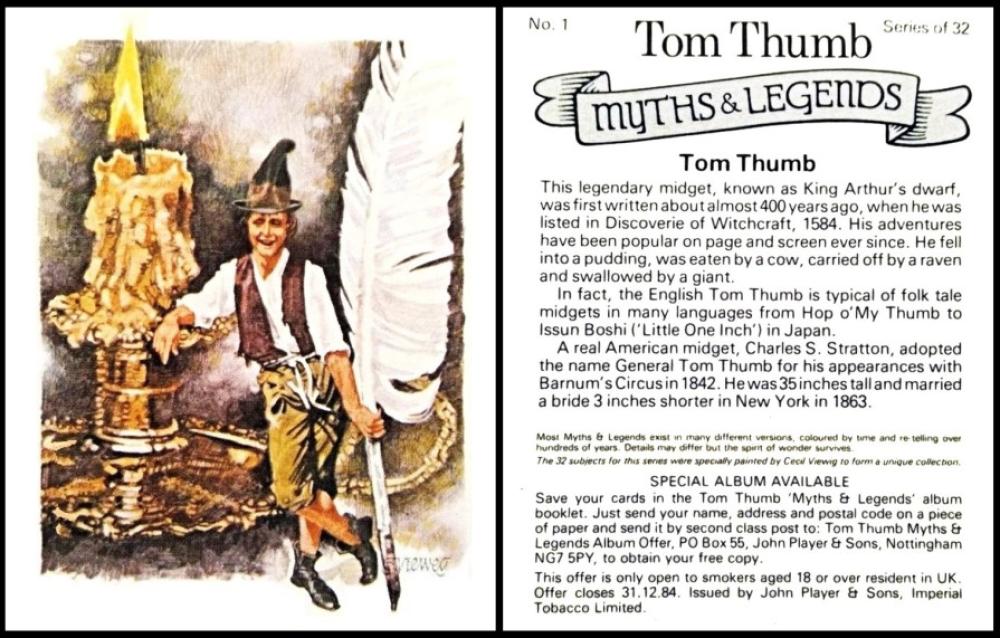
John Player & Sons [tobacco : UK - Nottingham] "Myths and Legends" - Tom Thumb brand (1981) 1/32 - P644-454
And so we start with the small - and also the one carried forward from last week because the date turned out to be wrong.
Now this card is a bit of a tangent from the subject - for the card shows a "Tom Thumb" who did not exist, whilst the date we celebrate here is of an actual person, Charles Sherwood Stratton, though he was called the non-existent name of "General Tom Thumb" by none other than Phineas T. Barnum.
Our man was born today in 1838, in Connecticut, America, the son of a carpenter, weighing a normal size, nine ounces and eight pounds. Then, at the age of six months, he stopped growing. His parents waited for another six months before asking their doctor, who pronounced that he would probably grow no more. He did continue growing though, as by the time he was five, he had grown about an inch taller, but not gained an ounce in weight. The growth was always small, sometimes between an inch and three inches, and over the period of between a year and five years. When he was twenty-four years old, he measured two feet ten inches.
Phineas T. Barnum seems to have heard about the remarkable boy and contacted his parents, offering to give the boy a chance in showbusiness, and to teach him acting, singing, and dancing. In 1844 he toured round America, and made quite a stir, and it was on this tour that he was first listed on the playbills as General Tom Thumb. After a break, the tour moved on, to Europe, for three years, during which he met Queen Victoria and the future Edward VII.
In 1863 he married, Lavinia Warren, who was also small, and a fellow performer. She seems to have taken a fancy to Charles Stratton before she ever saw him, so much so that she begged Phineas T Barnum to take her into the troupe. And though she was wooed by many, she was steadfast, and, after meeting Charles Stratton one day at Barnum`s American Museum, he was pursued by her so much that he eventually gave up and they were wed, at Grace Episcopal Church in New York, at an event that was definitely front page news.
Much is written of how performers are treated unfairly by their managers, but Phineas T. Barnum seems to have a good man, he allowed Charles Stratton`s parents to have a full say in everything to do with their son`s career, and allowed them to control the income as a proper business. Once the father died, in 1855, the money went to Charles Stratton alone, and Phineas T Barnum advised him on how to spend it best, two houses, one in New York and one in Connecticut, and a yacht, and, always, immaculate clothing, regularly replaced. And Charles Stratton helped Phineas T Barnum with money, several times, when the course of the tours did not run so smoothly. Eventually the pair made it official, and went into business together.
In 1883 Charles Stratton, and his wife, were among the very few survivors of a massive hotel fire. Then they are supposed to have started working at the Lyceum Theatre in Boston, which had been converted into a zoo, an aquarium, and a museum of curiosities. The Strattons were said to be amongst many celebrities at the opening, along with another man, an Italian, Count Primo Magri.. However that museum did not open until 1885, and Charles Stratton died less than six months after the hotel fire, aged just forty-five, of a stroke, after which he was buried in Connecticut, in a grave topped with a life size statue of him, paid for by Phineas T. Barnum.
After that, his wife wanted to bow out of showbusiness, but was persuaded not to. And a couple of years after this, she remarried, Count Primo Magri. They remained in the public eye, and even made a film together, in 1915, called "The Lilliputians' Courtship". She was then seventy three years old, and she lived for another four years, after which she was buried, next to Charles Stratton. This could have been demonstrating her true affection, but the truth is that her second husband was still alive, he only died in 1920.
Strangely I know of only one card that shows our man, and his wife - and that is number 19/24 of Cadbury`s "Strange But True", where he is billed as "The Miniature Man". Yet I am sure he must have deserved a place in either Ogden`s Tabs or Guinea Gold, I just have not been able to find him.
To our card - and it seems fitting that this Tom Thumb should have not only been issued by the cigars of the same name, but that he was number one in the set. Unusually, too, the artist`s name appears on the card, Cecil Viewig, not only as a signature, but in the credits; I cannot count how many times in the past I have bemoaned that the wonderful piece of artwork in front of me has absolutely nothing to show who created it.
The set is rather scantly described in our updated World Tobacco Issues Index (being issued too late for inclusion in our original 1950s volume) as :
MYTHS & LEGENDS. Nd. (32) ... P644-454
However it is very possible that I may be able to find the original "New Issues" report for this set and as soon as I do I will scan it and attach it here.
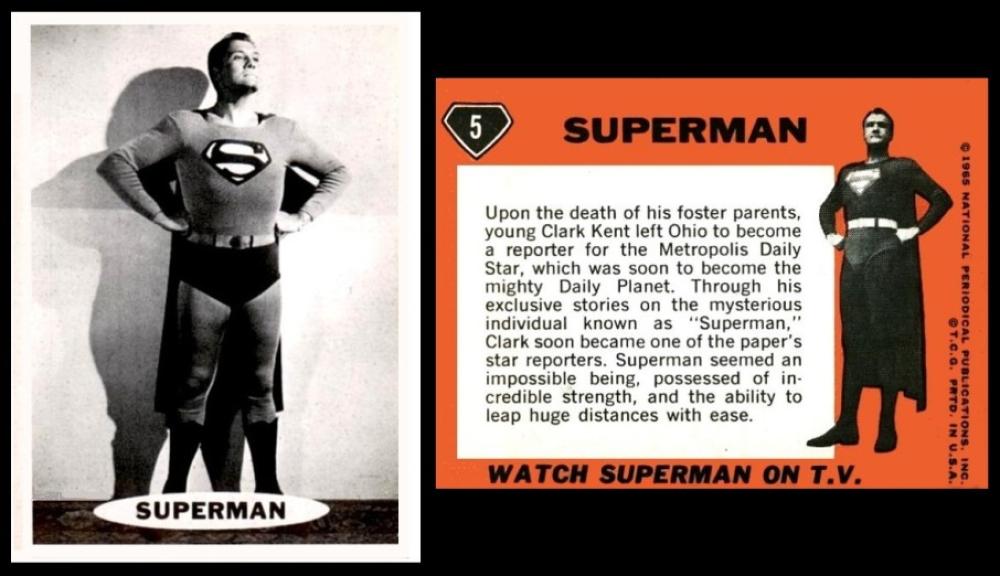
Topps [trade : bubble gum : USA] "Superman" (1965) 5/66
Off to the super now, with this man, George Keefer Brewer, born today in 1914. He seems to have had rather a turbulent childhood, his parents having only married a few months before his birth, and separating shortly after. Apparently his father married again, but never got back in touch with his former family. His mother moved about for a while, and settled with her sister in California, where she met and married another man, who seems kind, but they divorced, about ten years after. For some reason the mother told little George that his new father had died, though he lived until the mid 1940s.
When George Brewer went to high school, as many future stars do, he discovered theatrics, and he enjoyed them. In fact he declared that he was going to be an actor after he left school. He also got his first part in the movies, in "Gone With The Wind", with dyed hair, as one of the redheaded Tarleton brothers, who fail to sway Scarlett O`Hara`s heart away from the dashing Rhett Butler.
The next year saw him married, to a fellow acting student, put on contract by Warner Brothers, and acting in several films, all of which were released before "Gone With The Wind" had been, at last, finished, and deemed ready to screen - the final production having taken a year. Not long after that, Warners decided they did not want to retain his services. He moved to Twentieth Century Fox, and again was dropped. Eventually he picked up a contract to play Hopalong Cassidy, in five films, but was drafted into the U.S. Army Air Force in 1943, though he ended up with the entertainment department and even made training films for the forces.
After the war, and newly divorced, he went back to motion pictures. One of his parts, though not so big, was to prove important. This was in "From Here to Eternity", which won the Academy Award for Best Picture, something he was able to put on his resume.
In 1951 he was offered the chance to play a comic book character, Superman, on television. He was unsure, because at that time serious actors made films, not television programmes. However he was swayed by the fact that the first episode, the pilot, was going to be shown in cinemas, albeit as a supporting film to a better one. The only problem was that the contract was very rigorous, and exclusive, and it meant that he could not take any parts which could affect the hectic Superman schedule.
He is reported to have enjoyed the part, and it helped him to slow down his smoking habit too, for he could no longer smoke where children could see him. However, after two seasons he was getting bored, with everything. He was forty, and he wanted new adventures, more money, better roles, in films. He even started his own company, but he was enticed back to the Superman series by better money.
By 1959 he had ended one long term relationship and begun another. He was spending more than he had been getting for Superman, but there were rumours of another series, as well as a tour to promote it. However, he was not sure he wanted to play Superman ever again. Then, in June 1959, he was found, shot dead, at home. There is much speculation about who, and why, along with stories that he had decided to shoot himself because he did not want to play Superman again but could not get any other work. Most of the rumours that led to it being judged a suicide seem to have been started by his girlfriend of the time, possibly to cover something else up, and we will probably never know what. A recent-ish film, "Hollywoodland" (2006) explores a few theories, but that is all they are, and probably will ever be. There is no idea where the tale of his reported death at the Hollywoodland sign ever came from.
Now if anyone knows of a card which shows the Tarleton brothers from "Gone With The Wind", that would be his true "Rookie" card. However, at the moment, that honour goes to a package issue, printed, as part of a set of thirty-six unnumbered pictures, called "ATV Stars", on the side of a sweet cigarette packet, issued by Kane Products Ltd in 1958. ATV, or Associated Television, was part of ITV, the independent rival to the BBC. As BBC had considerably bigger fame and budgets, the ITV network used lots of little regional companies to provide their output, at different times of the week, hence ATV programmed were screened in London only at weekends, and in the Midlands during the week. Now thanks to the wonders of the internet, I know that on Wednesday the 20th of February, 1957, the programme "Adventures of Superman", starring George Reeves, had made its debut on ITV, so this must have happened in the Midlands region, though maybe it was repeated at the weekend for the London viewers. .
This set was issued by Topps in 1966, in packets of six cards and a stick of bubble gum, which retailed for five cents each. Oddly, some way into the series it picked up a sponsor, Kelloggs, but they do not seem to have issued any cards. The scenes come from the entire series, and cover all six seasons.
There is some debate over the date of issue of these cards, some sites saying 1965/1966, but the main set was definitely issued in 1966. The 1965 sets, of which there were very few produced, presumably for promotional purposes, had black and white backs, not pink, and there were only forty-four cards. However the orange back cards also say 1965, which was the date of the copyright.
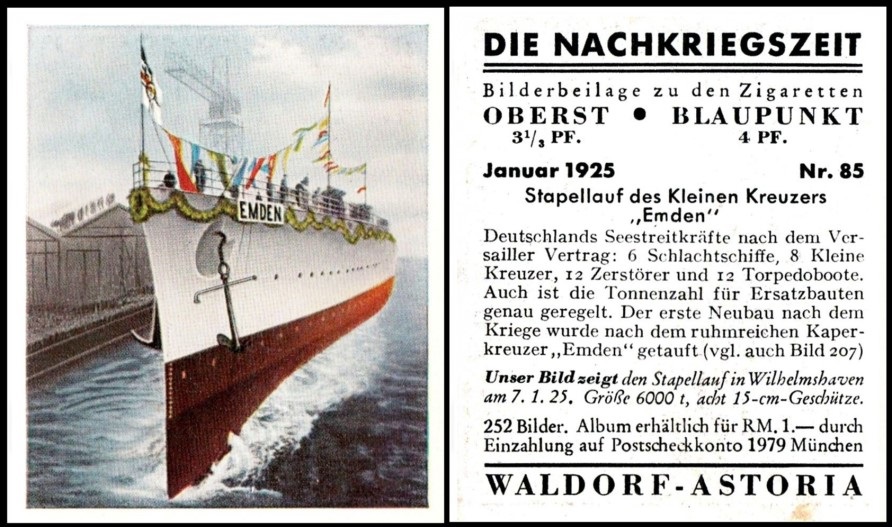
WALDORF-ASTORIA Zigarettenfabrik A.G. [tobacco : O/S - Munich and Stuttgart, Germany] "Die Nachkreigszeit" / "The Post War Period" (1935) 85/252 - W080-360 : W8-6 : X24/15.B
Today in 1925, a ship called Emden was launched, and, thanks to reader Mr. Jacobs, we now have a card which actually shows her (rather than the one we started with which showed the other Emden, which fought in the First World War).
This Emden was a cruiser, and she was used in the German invasion of Denmark, and Norway in April 1940, especially in the invasion of Oslo. The reason that those countries were required was that they led straight on to the North Sea, and to our shipping. There was another reason too, Sweden being a heavy producer of iron ore, which used to be, before the outbreak of the Second World War, exported to Germany. but was then being sent to Norway instead. After that she was used as a training ship in the Baltic, before joining on to the Baltic Fleet in Operation Barbarossa, the invasion of Russia. Like her predecessor, her end was at the hands of the Allied force, she was attacked whilst being repaired in Kiel, and then blown up to stop her falling into the Allied hands as their invasion seemed to be getting more likely.
This ship was one of several cruisers named after the city of Emden, starting with the 1908 SMS Emden, which was based in Asia, and her first action in the First World War was to pick up a Russian ship and transform her into a German ship, which it was felt could be used as a decoy. This did not work so well, and her crew became the first German forces either to be killed by, or become prisoners of war of American forces. She then took part in the Battle of Penang, and headed off to raid the Cocos Islands, then in British hands, which had a wireless station direct to Australia, via a cable which the Germans hoped to cut. However, whilst SMS Emden was there she was attacked by the Australian ship HMAS Sydney, during which about a third of the crew were killed and the rest taken prisoner. The ship survived, slowly falling apart until the 1950s, when it was taken away and scrapped.
Her replacement was the SMS Emden of 1916, which mainly operated on the Russian Front (remember that in the First World War, Russia was an ally), but she was scuttled at Scapa Flow in 1919.
The name has also been used since, for two frigates, in the 1960s and 1970s - and in this year, 2025, it is expected to be used again for a corvette.
This set first appears in our original World Tobacco Issues Index, along with a short heading about the company, which reads : "Amalgamated with G. Zuban in the 1930s. German language issues, period 1928-42. Includes brand issue inscribed "Oberst" and "Cigarettes-Bilderdienst, Dresden". Special albums issued." Our set is described as :
DIE NACHSKRIEGSZEIT (The Post War Period). Md. 62 x 52. Nd. (252). See X24/15.B ... W8-6
This text is identical in our updated version of this book, but without the "X" number, for that relates to the entry in the original handbook, which was at first a separate volume, but in later printings of the original World Tobacco Issues Index became combined therein.
The entry gives another issuer of this same set, and reads :
X24/15 DIE NACHSKRIEGSZEIT (The Post War Period). Medium size. 62 x 52. Numbered series of 252.
A. Eckstein-Halpaus
B. Waldorf-Astoria
You may not realise this, but Waldorf-Astoria was actually named after Johann Jakob Astor, and his birthplace, Walldorf. However he seems to have had no involvement in the company, save providing the inspiration and the name. The company was founded in 1906, and there were branches in Hamburg and Stuttgart. In fact it was one of the biggest employers in those regions, but they did not move with the times, and as new companies came in with more progressive ideas and better, faster, manufacturing equipment, it fell behind, and was liquidated in 1929. It was taken over by another company and ended up as part of the Reemstma stable, who were also based in Hamburg
As far as the other issuer, Eckstein-Halpaus Cigarettenfabrik G.m.b.H, well we showed a card from their version in our newsletter for the 2nd of November, 2024 - just scroll down to Thursday the 7th of November.
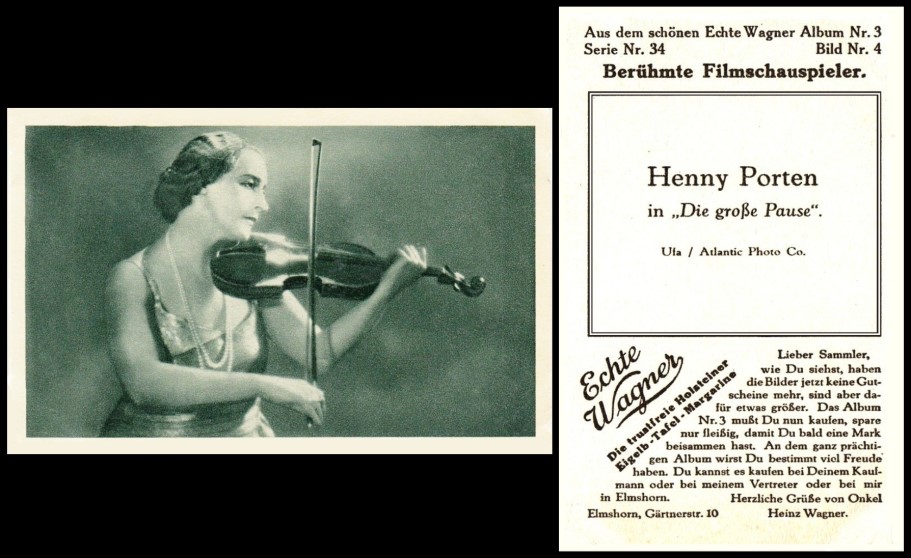
Echte Wagner [trade : margarine : O/S - Germany] "Beruhmte Filmschauspieler" (1928) Album 3, Series 34, Card 4
Today in 1890 saw the birth of Frieda Ulricke "Henny" Porten. Her name will probably be unknown to many of our readers but she was a very important woman indeed, for she was an actress and also a film producer, at a time when few women did those things, especially not in Germany. And it is true to say that her positive representation of women led to her becoming the first German superstar. She also had a huge output, almost two hundred films, counting both those she was in and those she worked on behind the scenes. And she was still making films into the 1950s.
She came from film stock, her father being both an actor and director. He almost certainly allowed her to watch and to help, and she became enthralled in the process. Strangely though, she showed no interest in going on the theatre stage, film was her one vocation, always.
She dreamed of starting a film company with her husband, who had been the director of her early films, but sadly he was killed in the First World War, in 1916. After the war, she simply started a company on her own. Her focus was always on telling stories of normal people, with an eye to social reform, and hoping that women were empowered to step away from the drudgery and repression that often formed their lives.
She remarried in 1921, to a doctor, of Jewish birth, and this caused her great trouble, she was unable to leave the country with him, and she refused to divorce him and go alone. She did make films, but under duress, though often with hidden symbols to foster, and encourage rebellion. And they did stay married, until his death, in 1959. She died just a few months later
This card is quite unusual for Echte Wagner, being monotone, with a greenish hue. The film shown, "Die Grosse Pause", is known in English as "The Long Intermission", and it was released on the 9th of November 1927, quite late in her career, and it is based on a play by Oscar Blumenthal and Max Bernstein. It was also directed by Carl Froelich, who had become involved with her own production company in 1924. However, little is known about the film, and the stills which remain do not give us much idea of the plot.
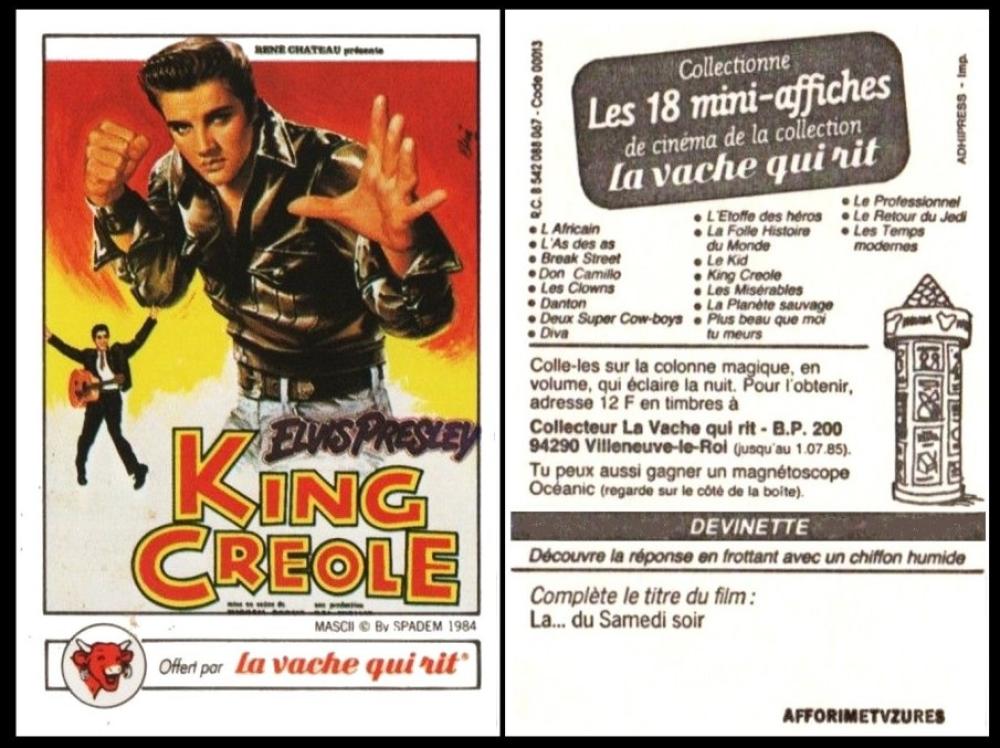
Bel [trade : cheese : O/S - France] "Mini-affiches de Cinéma" / "Mini Film Posters" (1984)
Still with a musical theme, but a slightly different one, for today, in 1935, saw the birth of Elvis Aaron Presley. He was a singer, and a teenybopper idol, but also he broke many barriers with his so called "provocative" performances, and his nods to many coloured musicians whose work would have otherwise been ignored at that time, as well as bringing it to a new, younger, and wider audience, who were more open to acceptance.
He was born in Mississippi, in Tupelo, but moved to Memphis in 1954 just as he became a teenager. His interest in music was encouraged by finding friends, and also by a visit to local company Sun Records, who wanted to break down the barriers so that music was universally acceptable.
His first single, "Heartbreak Hotel", was released in 1956 and became his first number one. In November of the same year he made his first movie, "Love me Tender".
After making the film on our card. "King Creole", in 1958, which Elvis always said was his favourite, he was drafted into the military. He was actually given deferrment so that he could complete the film. He was famous enough to have refused to do his time in the forces, but instead he chose to go, seeing his hair shaven and wearing regulation uniform. This endeared him all the further to his fans, though all agreed he looked very different.He went, as all military personnel, for basic training, and was then assigned to the First Medium Tank Battalion in West Germany.
He served for two years during which he met his wife, Priscilla, at a party. Her father was also in the military in Germany, but in the Air Force. When he came home he restarted his career and made several more movies.
His extended appearance in Las Vegas in the late 1960s led to many tours, and much worldwide acclaim, but he was already becoming unwell, and overweight. He died in August 1977, aged just forty-two.
Elvis appears on many trading cards, but this set is unusual It was issued by La Vache Qui Rit and is a series of film posters, which were designed to fit on a pillar that illuminated at night. This is shown on the back of the card. The posters are listed on the back of the card but they are in French, some time I will translate them for you. I notice one is "Return of the Jedi" though.
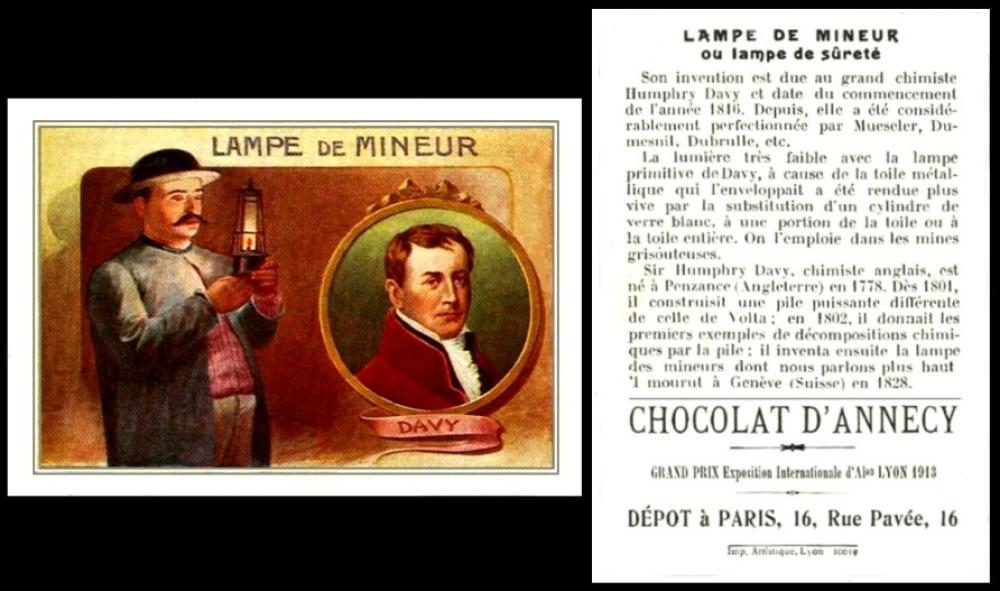
This is a super card, and it very ably commemorates the fact that today, in 1816, Humphrey Davy first tested his miner`s safety lamp, at Hebburn Colliery.
He produced the lamp not only because he was shocked by news of several explosions in coal mines across the North East, which had been caused by the flames of the miner`s lamps igniting small seams of gas that were opened as they worked - but because he was directly contacted by the Rector of Bishopwearmouth about the problem. Humphrey Davy ended up making several prototypes, refining each one, until he had a standard flame but with a sleeve of wire gauze. This allowed the light out, but did not allow the heat to pass through in sufficient quantity to spark an explosion.
The test was a great success and it led to the lamp being adopted in many areas. It did indeed lead to less miners being killed, but also to greater productivity, for the miners were not needing to dim their light and stop working the moment the flame flickered.
There was a rival though, George Stephenson, who was working as a mining engineer at Killingworth Colliery. His lamp, as you might suspect, was based on a very similar idea, and the two men were soon fighting over who owned the right to the system. For some reason, and I have not yet investigated this yet, Humphrey Davy`s lamp was the winner, which, amongst other things, led to him becoming the President of the Royal Society, whilst Stephenson, rather disgruntledly, went off and invented a way of powering locomotives by steam.
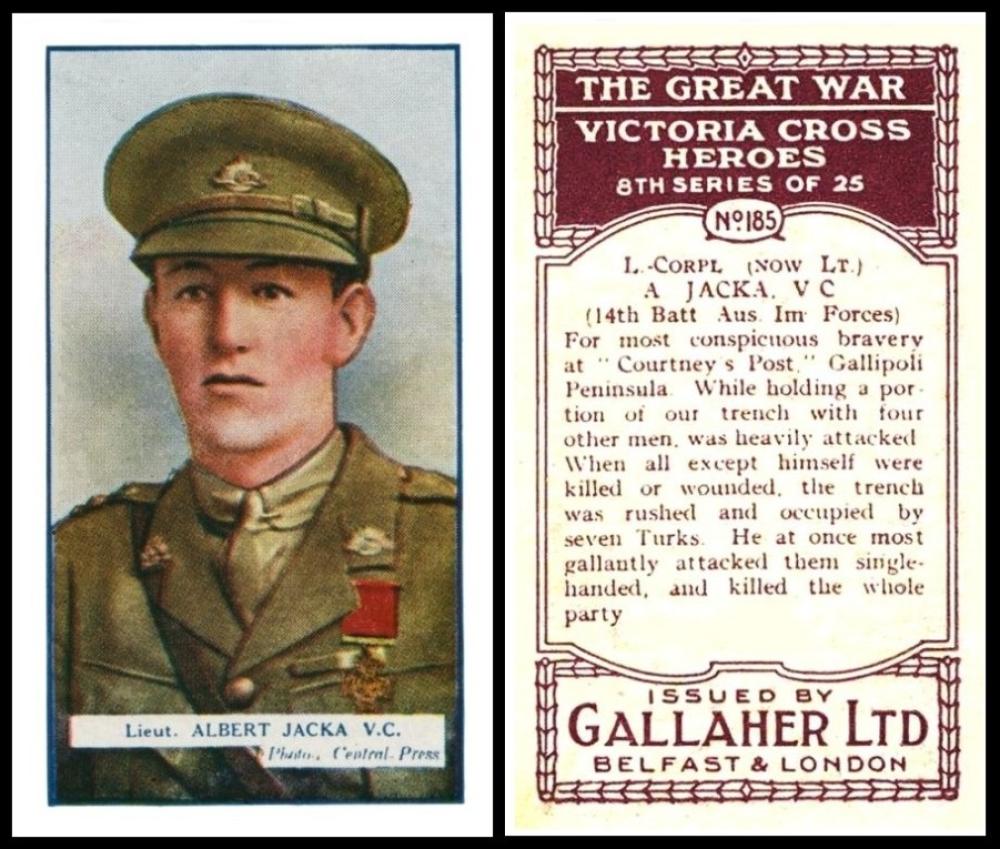
Gallaher Ltd. [tobacco : UK - Belfast & :London] “The Great War : Victoria Cross Heroes (1915) 8th Series of 25, card no.185 - G075-160.8 : G12-20.8 : Ha.492.3 : X1-Ha.492.3.A
And so we close, with this man, Albert Jacka, born today in 1893, and the first Australian to be awarded the Victoria Cross.
The medal was for his actions at Gallipoli, but he also fought on the Western Front, where he was awarded the Military Cross, twice (though only one medal can be awarded, the second is marked by a metal bar which fixes on the ribbon).
After he was demobbed he returned to Australia and set up as a shopkeeper, selling electrical goods, and eventually both importing them and exporting them. He also became Mayor of St. Kilda.
However he was never the same after his war service, he had been injured physically, and mentally, and reportedly, though he was not shy of starting or continuing fights, the event for which he won the Victoria Cross haunted him the rest of his life. He died, in January 1932, aged just thirty-nine.
I am sure there is a lot more to this story, so I will keep chipping away at it over the weekend. I have found an excellent web page on him at the Australian War Memorial/A.Jacka which contains his biography. Thrillingly, they also hold his medals.
As far as the missing data from our reference books, which I did not have time to add, this can be read elsewhere in our site, on the home page for this multi-parted set, as our Card of the Day for the 24th of June, 2022
This week's Cards of the Day...
..... have been remembering the coins of Europe which were swept away by the euro.
There are two dates involved with this process, and both are the first of January - the one in 1999 was the launch date, though there were neither coins nor banknotes, it was, at that time, purely for accounting and electronic transactions. As for the actual euro currency, the sort you could hold in your hand, and jangle in your wallet, that was only available from the first of January 2002.
The arrival of the euro affected many countries, though some of their coins had the same name. All of them had stories, some long and fascinating. And it was the largest monetary changeover in history, for though there had been more than a few regional alterations, nothing had ever replaced so many countries all at the same time.
So our clue cards this week were..... :
Saturday, 28th December 2024

Unusually, this card was chosen for the first name of the featured player, Mark, primarily for the Deutsche Mark, which was the coinage of Germany - and has a long story, being also used in many of the areas which were eventually combined to form modern Germany. In fact it was only named Mark in the ninth century, and that is a Latin word relating to weight, specifically eight troy ounces of gold.
It was also used, through the years, in the German colonies, as well as Estonia and Poland, but the only other country than Germany using it at the time of the changeover to the euro was Finland, though they called theirs either the Marka, or the Markka.
And it still remains the currency of Bosnia/Hercegovina
Our featured player, Mark Thomas Lawrenson, was born in June 1957, in Preston, in Lancashire, but he played internationally for the Republic of Ireland, his grandfather having been born in Waterford.
He is shown here in his Liverpool strip, but he started out with his home side, Preston North End. Brighton and Hove came after, starting in 1977, though interest was also shown at that time by Liverpool. Then, towards the end of his time at Brighton and Hove Albion things were not going so good for the side, and many cutbacks were being made, one of which saw our man being put up for sale, in 1981 - and, this time, Liverpool did manage to secure his services, for the record fee of £900,000.
Today, he is best known for this time with Liverpool, during which they won many honours, both in the league and internationally. However, despite the glory, in 1988 he was injured, in what was at first thought to be just a minor way, but from which he never really recovered to full strength. He then moved into managing, and had a few seasons with smaller clubs, before moving into commentating on television and radio, something which he not only enjoyed, but proved very good at.
This set was issued with "candy sticks", which older readers, including me, remember by another name, of sweet cigarettes.
For some reason, they went to the expense of printing several different boxes, not just changing the colour but the artwork on the front as well. You can see them all at the Trading Card Database/PackagingBF83 - and this also shows the album, for which the cover picture is yet another picture.
There`s a checklist for the set there too, on another page.
Sunday, 29th December 2024
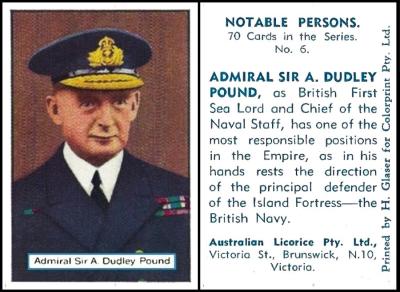
This card stands for the Pound. Now you may know that as the standard British coinage, but maybe not that the name was first used in 1489. However the British Pound was not replaced by the euro.
There were other Pounds though - the Irish Pound, dating from the tenth century - and the Cypriot Pound, first used in 1879.
The removal of the Cypriot Pound did not affect the self-proclaimed Turkish Republic of Northern Cyprus, who did not choose to use the euro, nor the Pound; instead, they use the Turkish Lira.
Here we have Admiral of the Fleet Sir Alfred Dudley Pickman Rogers Pound, GCB, OM, GCVO, born in 1877, and who came to prominence in the First World War, as a result of his actions at the Battle of Jutland. By the time of the Second World War he was sixty years old, and serving as First Sea Lord, the figurehead of the Royal Navy, a job he did for four years. However, though he showed moments of brilliance, especially in the Battle of the Atlantic, there were also failures, the Norwegian Campaign, and the disaster that resulted from his decision not just to spread out Convoy PQ17 after they left their base in Iceland, but to not have covering forces in place - a decision which resulted in the loss of a hundred and fifty three merchant seamen, and twenty three ships, along with their valuable cargos, almost three thousand five hundred vehicles, and over two hundred aircraft. Within a year he had resigned, citing health reasons, and he died shortly after in 1943.
This proved to be a really fascinating set, with several twists. That code is from our original Australian and New Zealand Index, RB.30, issued in 1983, and in there the set is listed as :
Notable Persons. 60 x 41. Nd. (77). Number in series revised to exclude enemy personalities. Backs inscribed "77 Cards in the Series", later revised to "71 Cards", "70 Cards" and "68 Cards". First issued 1940. ... AU2-20.
By the time of the updated volume, part II, published in 1993, there had been quite a lot of research done, In the main Index the set is recorded as :
AU2-20. (Notable Persons). Subjects known in the four printings are listed under A.30, Handbook Section
The Handbook is at the reverse of the book, and there is indeed a list of all the cards. This will be scanned and uploaded into here tomorrow, but there is something intriguing that I will discuss now and that is the reference, in the original Australian and New Zealand Index, to the excluded cards being "enemy personalities". In fact, though the identities of two of those six cards were not known when our book went to print, these being cards 72 and 77, there is only one card that this applies to, and that is card 25, Herr Von Ribbentrop (Germany`s Foreign Minister). The other cards removed were :
card 73 - The Late Mr. J. V. Fairbairn (James Valentine Fairbairn, a fighter pilot in WW1, later the Australian Minister for Air and Civil Aviation, who died in an air crash in August 1940)
card 74 - Sir Thomas Blamey (Thomas Albert Blamey, the Commander of the Volunteer Expeditionary Force of the Australian Army in the Second World War).
card 75 - Admiral Colvin (Ragnar Musgrave Colvin, Commander of the Royal Australian Navy at the start of the Second World War)
card 76 - Flying Officer E "Cobber" Kain (Edgar James Kain, New Zealand fighter pilot, serving with the Royal Air Force. He also died in 1940, in an air crash, a farewell flight just before leaving his squadron)
Monday, 30th December 2024
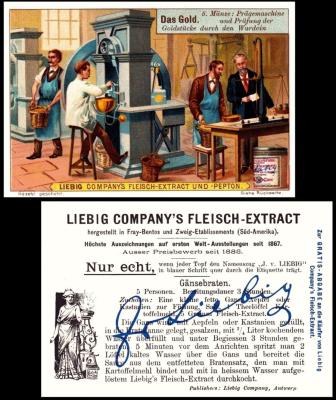
This card has two important connections with our theme.
The first connection is that though this set shows the various uses of gold, this card shows it being converted into items, namely (as this is the German version of this set), "Munze", which is German for money.
The second connection, though, relates directly to the Dutch Guilder, which actually means "Gold Coin" - and that coin has one of the longest continuous usages of all, from 1434 until 2002.
The set was issued in several versions; in Belgium and France as "L`Or", in Germany (our version) as "Das Gold", in Italy, as "L`Oro", and in the Netherlands as "Het Goud". All of these literally mean "The Gold", but collectors seem to refer to it as simply "Gold". Strangely the easiest to acquire seem to be the Belgian and the German, and though the French set has the same title, it is one of the hardest to find, though, for some reason, the Netherlands one is really scarce.
As for the cards in this set, they are very well drawn, though the first four cards are concerned with different ways of extracting the gold, the fifth, ours, showing what is usually done with it, and the last of all being three men and a woman working on objects, whilst displayed in the front of the card are golden treasures. The full list of cards is :
- Gold hunting in the Klondyke
- Extracting gold from soil with a hopper
- Mining in the Transvaal
- Washing gold in Africa
- Minting money
- A goldsmith at work
Tuesday, 31st December 2024
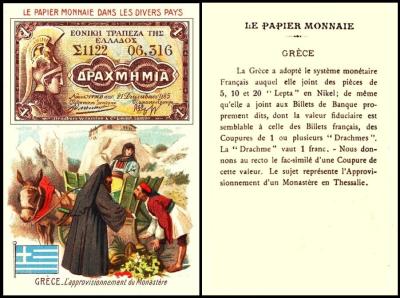
Now our card today remembers the Drachma, currency of Greece, another one with a very long story - and although it is often said that this began in 1833, if you were to jump in a time machine and travel back to sixth century ancient Greece, you would find that their coinage was also drachmas, and that every state was allowed to mint their own, using symbols unique to them. But before that, the drachma was also used as a kind of currency, for it meant a bundle of arrows or rods, and these were the first tools used for bartering, before the coin was even thought of.
When I revealed the front of this card I had no idea that a reader was going to supply the next one, a cunning variation. And when I revealed the front of that one, I was able to turn it into a "spot the difference" teaser for the New Year. Well, to put you out of your misery, there are two main differences, one per side. First up, to the bottom of the front of this card you will only find one line wording in black which tells the name of the Country, and describes the scene - whereas on tomorrow`s card there is a second line of printing, in red, which reads "Edition de la CHOCOLATERIE d`AIGUEBELLE (Drome)". And second, below the descriptive text on the reverse of this card, there is a vacant space, but tomorrow`s has been filled with an advertisement.
Today we are fairly sure that what happened (and it is quite common with Continental cards, as well as with early American Trade cards) is that a commercial traveller, reprsenting the printer, would go around to businesses and show them a black card, and tell of how easy it would be to have their company name along the bottom, and their advertisement in the empty space behind, sure to bring in new business in order for them to collect the whole set. And often the business would agree.As far as the printer was concerned, especially if a bulk lot was printed up as blanks, it was a good way of making money, for each new business would be billed for the complete job, but the only ink used would be for the overprinting, hence extra profit for the printer.
As for why there are blanks out there, there are two schools of thought, and the truth is that both are valid. Sometimes the unused blanks were just hanging about, and the printer sold them off, or gave them to his friends - whilst other times a business liked the cards, but ummed and ahhed, not wanting to pay for having the addition of their name, and, if the commercial traveller was a canny one, he would offer a cut price deal for just the blanks, and often the business would agree. Though to collectors this is a bad thing, for there is no way to tell how many companies did issue the set, or from which regions they came.
Wednesday, 1st January 2025
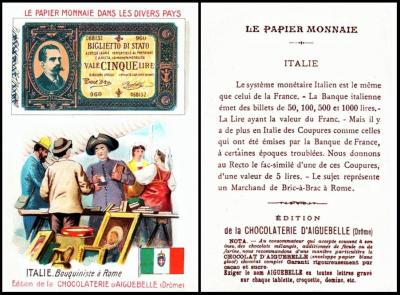
This card celebrates the Lira, one of the most widespread currencies ousted by the euro, for it was not only used in Italy, as shown here, but in Israel, Malta, San Marino, and in the Vatican State, as well as former Italian colonies in Africa. It still remains in Lebanon, Syria, and as we found out earlier in the week, in the Turkish part of Cyprus.
The name Lira also came from the Roman Empire, Libra being Latin for Pound. And in fact British coinage also had Librae, it was the L in L.S.D. (by which I mean Librae, Solidi, Denari - not the other L.S.D., Lysergic Acid Diethylamide)
Now since featuring this set, we have had more contact, and other issuers are already starting to turn up. We can therefore add :
- CHICOREE BLEU-ARGENT, ARLATTE & CO
[another coffee substitute, made by Arlatte * Co of Cambrai, France] - CHICOREE des ROIS C. BERIOT à Lille
[this translates to "Chicory of Kings", a coffee substitute made by C. Beriot of Lille in France] - CHICOREE NOUVELLE, CASIEZ -BOURGOIS, CAMBRAI
[New Chicory - coffee substitute - by Casiez-Bourgois, of Cambrai] - LA TISANE DES PERES CELESTINS
[a monastery in Paris, however it is variously reported as coffee, tea, or herbal medicine] - Mon. L. PHILLIPE, Brest
[absolutely no idea on this one] - PHOSCAO -
[hot chocolate, the maker being A. Dardanne et Fils, but this is not listed on the cards]
And if any readers can add any more, please do.
Now I do not know for sure how many cards make a full set, but I started the list which follows with just six cards, and since asking around it has grown considerably. And I welcome the titles of any others you know, other than :
- Allemagne [Germany]
- Angleterre - [England]
- Autriche Hiongruie [Austria and Hungary, or Austro Hungary]
- Belgique [Belgium]
- Bulgarie [Bulgaria]
- Canada [Canada]
- Danemark [Denmark]
- Espagne [Spain]
- Etats-Unis de l`Amerique du Nord [The United States of North America]
- France [France]
- Grece [Greece]
- Hollande [Holland]
- Italie [Italy]
- Japon [Japan]
- Mexico [Mexico]
- Portugal [Portugal]
- Roumanie [Rumania]
- Russie [Russia]
- Serbie [Serbia]
- Suede et Norvege [Sweden and Norway]
The unusual one is Autriche Hiongruie, which is the Austro-Hungarian Empire, which began in 1867 and ended in 1918. Curiously it was two Sovereign States, but only with only one King, known as either the Emperor of Austria or the King of Hungary, depending on where you lived. That means these cards were definitely issued before the First World War
Thursday, 2nd January 2025
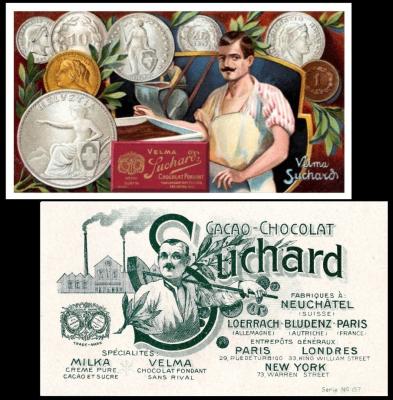
Here we have the Franc, but the Swiss Franc, which was not replaced by the euro. Instead both currencies are equally accepted within Switzerland.
However other Francs did fall, namely those of Andorra, Belgium, France, Luxembourg, and Monaco.
The most famous of these was the French Franc, which was reportedly first used to pay the ransom of King John II, after he had been captured by the English at the Battle of Poitiers in 1356.
The Belgian Franc began in 1832, the date of their independence from the Netherlands. Before then Belgium having used the Gulden, (a currency closely related to the Dutch Guilder).
The Luxembourg Franc was first issued in 1854, before that they had used the Dutch Guilder, the Belgian Franc, and the Prussian Thaler. It was replaced by the Reichsmark in 1941 when the country came under German occupation, but restored in 1944.
Andorra, amazingly, never had its own currency, it used the Spanish Peseta, the French Franc and the Monagasque Franc, though actually Monaco only had their own Franc in short bursts, starting in 1837 and 1838, and then removed from circulation until 1879; this was taken out of circulation in 1904, and did not return for twenty years. From then on it followed the pattern of being issued, but only for two or three years. It was only in the last years of the 1950s that it lasted for longer, right until 1995/6, and then it was replaced by the euro.
Not sure how many of these cards there were, but we have a little list, supplied by the sender of this card, Mr. Porter. The cards are actually numbered, though it is not very visible, it is bottom right but inside the picture, so it does not show up too clearly. They are untitled though, and you can only tell what the countries are by squinting at the coins shown. So this list, very usefully, gives you the country and a description of the picture.
The cards he knows of so far, therefore, are :
- France - an early motorist with goggles and a car behind
- England - a man with a ship being built behind
- Russia - a man with a knife
- Mexico - a man with a block of stone hanging behind
- Austria - a man blowing glass with furnace behind
- America - a man with a board of levers and gauges
- Switzerland - a man in an apron making chocolate
- Spain - a woman with oranges in her arms
- Norway - a man with a large cooking pot
And if anyone can supply the names of the missing cards, he would be most grateful.
Friday, 3rd January 2025
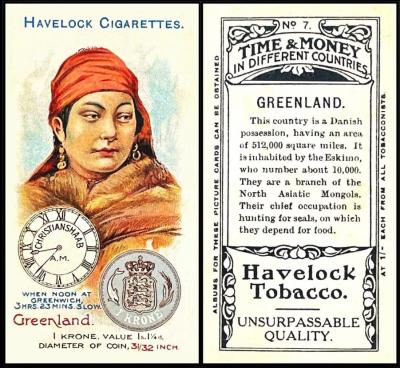
Our final card of the week brings us the Krone. This, in all its variant spellings, covered a lot of ground, pre-euro, and it was used in Austro-Hungary, Denmark, the Free State of Fiume, Greenland, Iceland, Norway, Sweden, and Yugoslavia. However it was also used under slightly different names in Bohemia, Czechoslovakia Moravia and Slovakia (all as the Koruna), Croatia (as the Kuna), Estonia (as the Kroon), the Faroe Islands (as a Krona), and Hungary (as the Korona),
Today you can still use the Krone, in Denmark, the Faroe Islands, Greenland, Norway and Sweden.
Now this set has several variations, which are all discussed elsewhere on this site, as our Card of the Day for the 24th of May 2024 - and we used this same front. However, this one is the most puzzling for the other two Australian versions are blank to the top of the front, whilst this one shows "HAVELOCK CIGARETTES"
The group was first catalogued in our original Wills reference book part III, as :
104. 50. TIME AND MONEY in Different Countries. Fronts lithographed in colour; backs in grey with descriptive text. Issued 1908. ... W/104
HOME ISSUE :-
A. With I.T.C. and Album Clause
AUSTRALIAN ISSUES :-
B. With "Capstan" advertisement, without Album Clause on backs.
C. With "Havelock" advertisement, with Album Clause on backs.
D. With "Vice-Regal" advertisement, without Album Clause on backs.
Similar series issued by Smith, and Fry (Trade).
In our World Tobacco Issues Indexes the set is split, with the home issue in section 2A and the Australian issues either under 2.B in the original version, or 4.B in the updated version. In both, the set is catalogued more succinctly under the home issue as :
TIME AND MONEY IN DIFFERENT COUNTRIES. Sm. Nd. (50).
and then the Australian section continues this with
Brand issues. See W/104 and H.454
A. "Capstan" back
B. "Havelock" back
C. "Vice-Regal" back. (a) with (b) without album clause.
And as for the text from H.454, which is the handbook, you can read that in full at the home page for this set
As for the other currencies that were lost to the euro, we chatted about the Austrian Schilling in a previous newsletter, that of the 14th of December, 2024, just scroll down to Friday the 20th of December.
This only leaves uncovered the Latvian Lat, the Lithuanian Lita, the Portuguese Escudo, the Slovenian Tolar, and the Spanish Peseta. I will add those in either as part of a future newsletter, or, more likely, expand here, though I admit that some of these will be way easier to find than others....
Anyway time has beaten me once more, and I must away.
Hope you enjoyed this little trip through vanished coinage, and to countries that awakened memories of past holidaymaking - or maybe inspired you to revisit your dreams of going there once more. Perhaps, too, it will send you to your albums to check out some of your cards on the subject. And if you find any I could not, do let us know!
